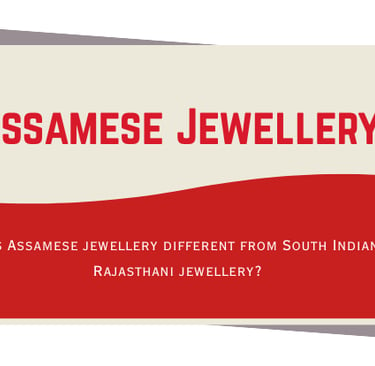How is Assamese jewellery different from South Indian or Rajasthani jewellery?
Blog post description.
ASSAMESE TRADITIONAL JEWELLERY
Kasturi Gogoi


Assamese jewellery stands out for its simplicity, symbolism, and handcrafted artistry that beautifully reflect the region’s culture and nature-inspired designs. Unlike South Indian jewellery, which is often grand, temple-inspired, and heavy in gold, Assamese ornaments are more delicate and lightweight, featuring motifs of flowers, birds, and the moon. Rajasthani jewellery, on the other hand, is known for its opulence, colorful gemstones, and detailed meenakari work. Assamese pieces like Jonbiri, Lokaparo, and Gamkharu carry cultural stories and emotional meaning, often linked to folklore and femininity. These ornaments use fine gold or silver with red and black enamel detailing — a signature style called mina work. While South Indian and Rajasthani jewellery highlight royal grandeur, Assamese jewellery expresses natural elegance and spiritual symbolism, representing the unique identity and heritage of Assam’s people and artisans.
How Assamese Jewellery Differs from South Indian and Rajasthani Jewellery
Introduction
Jewellery in India is deeply tied to regional identity, craftsmanship, and culture. Every state has its own artistic language, and Assamese jewellery is no exception. Known for its graceful simplicity and deep cultural symbolism, it contrasts sharply with the grand, heavily ornamented designs of South Indian and Rajasthani traditions. Assamese ornaments are not just accessories — they tell stories of the land, nature, and people of Assam.
Origin and Historical Influence
Assamese jewellery dates back to the Ahom dynasty, where royal goldsmiths (sonars) crafted intricate ornaments for queens and nobles. These designs were influenced by nature — featuring motifs of birds, flowers, and celestial symbols.
In contrast:
South Indian jewellery evolved from temple traditions and ancient Dravidian architecture, often depicting deities and mythological figures.
Rajasthani jewellery was shaped by Rajput royalty, reflecting wealth, status, and vibrant desert aesthetics through ornate patterns and gemstones.
Cultural Symbolism and Meaning
Each region’s jewellery carries its own meaning:
Assamese Jewellery: Focuses on grace, femininity, and harmony with nature. Designs like Jonbiri (moon-shaped) and Lokaparo (twin pigeon motif) symbolize purity, love, and unity.
South Indian Jewellery: Symbolizes devotion, prosperity, and divine blessings, often worn during religious ceremonies.
Rajasthani Jewellery: Represents power, pride, and royalty, adorned with colors and jewels that mirror Rajasthan’s rich heritage.
Design and Craftsmanship
Assamese jewellery:
Made from fine gold or silver, with distinctive red and black enamel known as mina work.
Lightweight, elegant, and inspired by natural forms.
Common pieces include Gamkharu, Dugdugi, Jonbiri, and Thuriya.
South Indian jewellery:
Heavy and elaborate, featuring temple motifs, coins, and goddesses.
Often made of 22k gold with Kundan, rubies, and emeralds.
Rajasthani jewellery:
Rich in color and texture, showcasing Polki, Kundan, and Meenakari techniques.
Uses gold, silver, and gemstones like turquoise, coral, and pearls.
Artistic Techniques
While all three traditions celebrate craftsmanship, their techniques vary widely:
Assam: Mina work and delicate engraving passed down through families of goldsmiths.
South India: Temple jewellery with embossed gold and filigree work.
Rajasthan: Intricate enamelling (meenakari) and gemstone inlay that emphasize color and shine.
Occasions and Cultural Use
Assam: Worn during Bihu festivals, weddings, and folk dances like Sattriya.
South India: Integral to weddings, temple rituals, and Bharatanatyam performances.
Rajasthan: Displayed during royal ceremonies, festivals, and traditional folk events.
Each region’s jewellery carries emotional and spiritual value, connecting the wearer to local traditions and beliefs.
Modern Adaptations
In recent years, Assamese jewellery has gained national recognition for its elegance and symbolic depth.
Designers now create lightweight and fusion versions for modern outfits.
Assamese brands are reviving heritage pieces through online platforms.
South Indian and Rajasthani jewellery continue to influence bridal and luxury fashion, while Assamese designs appeal to those seeking meaningful simplicity.
FAQs
1. What makes Assamese jewellery unique?
Its nature-inspired motifs, moon and bird designs, and enamel detailing set it apart from other regional styles.
2. How is Assamese jewellery different from South Indian jewellery?
Assamese jewellery is minimalist and symbolic, while South Indian designs are grand, temple-themed, and heavy in gold.
3. How does Rajasthani jewellery differ from Assamese jewellery?
Rajasthani ornaments are colorful and gemstone-rich, while Assamese pieces are elegant, enamel-finished, and more understated.
4. Can Assamese jewellery be worn with modern outfits?
Yes, many fusion designs pair beautifully with contemporary and Indo-Western clothing.
5. Are Assamese ornaments made only in gold?
Traditionally yes, but modern versions are also crafted in silver or imitation metals.
Conclusion
Assamese jewellery stands apart in India’s diverse cultural landscape for its quiet elegance and meaningful symbolism. While South Indian and Rajasthani jewellery dazzle with grandeur and opulence, Assamese designs capture the soul of nature and emotion. Each piece — from Jonbiri to Gamkharu — tells a story of heritage, artistry, and identity. In today’s fashion world, Assamese jewellery continues to represent the beauty of simplicity and the pride of Assam’s cultural roots.